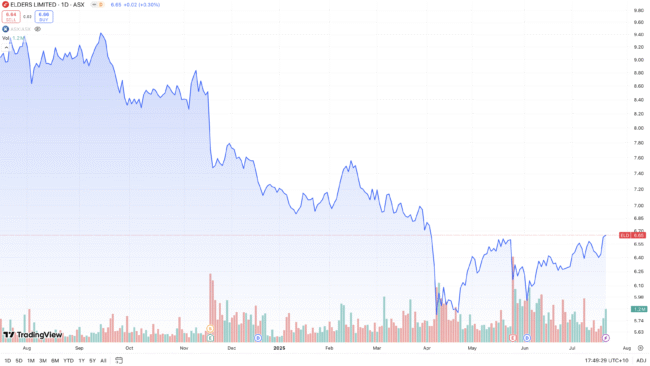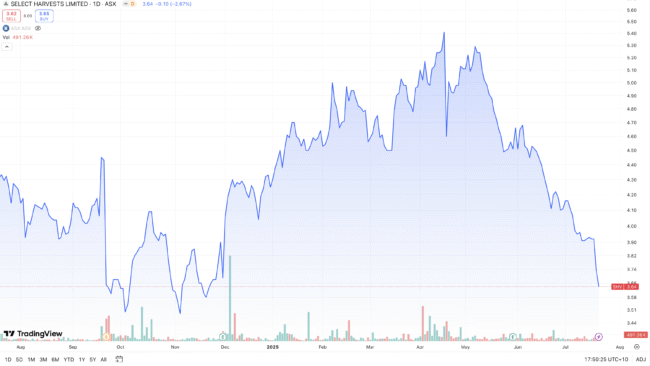Here are two great-looking stocks from the agricultural sector that appear well-positioned right now.
It seems like every time you turn on the television, there are floods somewhere, and drought somewhere else. For example, at present the nation has large parts of the south-east struggling with dry conditions, while Western Queensland and coastal New South Wales are cleaning-up after devastating flooding. Add to that the ongoing volatility of the global economy and trade system, and Australia’s agricultural industry has a lot on its plate –despite the longer-term tailwind of rising global demand for food and agricultural products, fuelled by both population growth and rising middle classes – especially in the Asia-Pacific region.
In 2025/26, the Australian Bureau of Agricultural and Resource Economics and Sciences (ABARES) forecasts the value of Australian agricultural production to fall by 2.8%, to $90.7 billion, driven by lower crop and livestock production volumes – which would still represent the third-highest result on record.
Here are two great-looking stocks from the agricultural sector, that appear well-positioned right now.
-
Elders (ELD, $6.63)

Market capitalisation: $1.3billion
12-month total return: –23.1%
3-year total return: –12.7% a year
FY26 (September) estimated yield: 5.7%, 60% franked (grossed-up, 7.1%)
FY26 (September) estimated price/earnings (P/E) ratio: 10.4 times earnings
Analysts’ consensus price target: $8.34 (Stock Doctor/Refinitiv, eight analysts); $8.72 (FN Arena, four analysts)
Elders is one of the true household names of the Australian Securities Exchange (ASX). It is one of Australia’s leading agribusinesses, with an iconic brand, 185 years of history and a national distribution network with currently 608 branches throughout Australia, across either the Elders (260 stores) or AIRR (348 member stores) brands. The company supplies rural farm inputs (such as seeds, fertilisers, agricultural chemical and animal health products, and agronomic services) and provides agency (livestock, wool and grain trading), real estate, financial and feed and processing services. In its stores, Elders is “the Bunnings of the Bush,” and is a one-stop-shop for agricultural services.
Elders’ geographic and product diversification is key strength of the business. National diversification means that 33% of underlying profit comes from Victoria and the New South Wales Riverina; 23% from the rest of NSW; 18% from Western Australia; 15% from South Australia; 7% from Queensland and the Northern Territory; and 3% from Tasmania.
Retail products generate 45% of the gross margin, followed by agency services, 19%; real estate services, 12%; wholesale products, 12%; financial services, 9%; and feed and processing services, 3%. Seasonal conditions play a significant role in determining the trend of these drivers.
In May, Elders reported a first-half performance (six months to March 31) that showed a recovery from a challenging prior period, with most products and services achieving an uplift year on year. This was driven by improved livestock prices and production margins – which boosted sentiment in the livestock industry – and real estate growth. Sales rose 5% to $1.4 billion; underlying earnings before interest and tax (EBIT) grew by two-thirds over the year, to $64.3 million; and reported net profit almost tripled, to $33.6 million.
Without giving formal guidance Elders was positive on the outlook for the full year (which ends on September 30), with chief executive Mark Allison saying that the outlook generally and nationally for the agricultural industry was positive, that international demand for protein remains historically high and global indicators for trade were positive. Elders expects a solid second half driven by strong livestock markets, real estate demand, and cost containment.
An external factor on which the market has been keeping an eye is that Elders has announced a deal in which it will pay $475 million to buy Delta Ag, a private equity backed firm that provides everything from real estate services to bulk fertiliser supply. Delta operates 64 retail stores, primarily in regional areas of New South Wales, Victoria, South Australia and Western Australia, and also operates a wholesale business (Delta WA) in Western Australia. Because the proposed deal involved the number two player buying the number three player (a rival one-third its size) that operates in many of the same towns, the Australian Competition and Consumer Commission (ACCC) was bound to take a close look, and in May the regulator announced that Elders would need to sell some of its rural supplies stores to win approval.
That would represent a blow to Elders’ growth plans, but at present the ACCC’s concerns are only at the preliminary Statement of Issues (SOI) stage: Elders and Delta say they will continue to engage constructively with the ACCC to address the issues expressed in the SOI. The ACCC anticipates making a final decision on 21 August 2025.
In the meantime, analysts see rising profit this year (to September 2025) and the next two years, particularly FY26, as Elders’ geographical and commodity diversification proves its worth.
Analysts predominantly say Elders is cheap, with strong upside potential. The most bullish broker is Bell Potter, which has a price target of $9.10 on the stock.
-
Select Harvests (SHV, $3.74)

Market capitalisation: $531 million
12-month total return: –10.6%
3-year total return: –8.3% a year
FY26 (September) estimated yield: 2.9%, unfranked
FY26 (September) estimated price/earnings (P/E) ratio: 9.7 times earnings
Analysts’ consensus price target: $5.30 (Stock Doctor/Refinitiv, seven analysts); $5.41 (FN Arena, three analysts)
Select Harvests (SHV) is Australia’s second largest almond producer – behind Canadian investment fund PSP Investments, which has about 12,000 hectares under production – and the largest listed almond company in the world. The company produces about 28,000 tonnes a year across seven regions in southern New South Wales, northern Victoria and eastern South Australia, from more than 9,371 hectares of company-owned and leased almond orchards and land suitable for planting. These 15 orchards, plus other independent orchards, supply Select’s state-of-the-art processing facility at Carina West near Robinvale in Victoria. The Carina West processing facility has the capacity to process more than 40,000 of almonds in the peak season, and the second phase of a $6 million upgrade will increase that capacity to 50,000 tonnes by the end of the current financial year.
Select Harvests is fully integrated, with expertise covering horticulture, orchard management, almond processing, sales and marketing, which enables it to add value across each of its business activities. The company supplies the Australian and global almond markets, with about 80% of its production exported. Under its global brands Renshaw and Allinga Farms, Select supplies a full range of premium value-added almond products (blanched, roasted, sliced, diced, meal and paste) in multiple customer categories (beverage, bakery, confectionery, cereal, snacking, health, dairy (ice cream), re-packers and wholesalers) to more than 600 customers globally, spread across Asia (in particular, the fast-growing markets of India and China), Europe and the Middle East.
The planets are aligning nicely for Select, as its major rival, California – which produces about 80% of the world’s almonds, with about three-quarters of its produce exported – has struggled in recent years, from drought, weaker almond prices and depressed land valuations. But global almond prices have fought back to decade highs, and the US Department of Agriculture forecasts the second-largest Californian harvest in history in 2025, at 3 billion meat pounds, up 10% on the 2024 crop. However, just when the industry has recovered, along came tariffs.
It’s President Trump’s trade war with China that has put a rocket under almond prices. Beijing has slapped a 35% punitive tariff on US almond producers, virtually locking them out of the market.
That has given Australian farmers a rare opportunity to boost both their market share and their pricing power, charging China – which was already a big buyer of Australian almonds under the Australia-China free trade agreement – premiums for their produce.
Effectively, Australian growers are benefiting from a perfect storm: a trade war is preventing their major rival from selling at a competitive price into major markets like China; the global crop has reduced; prices are at a ten-year high; and local producers have a low Australian dollar to augment their revenue even more.
Australia accounts for about 10% of the global almond supply, but it is getting the chance to place its product into even more markets.
While this market situation is a bonus for Select Harvests, it was on track for a good year anyway, reaffirming its 2025 crop forecast at 25,250 tonnes, with about three-quarters of that already sold under contract. This has helped greatly, as the better-than-expected US crop estimate took about 17% off almond prices, to about US$2.50 a pound: SHV points out that the US crop is yet to be harvested and processed, meaning that its remaining crop is being sold into a market that cannot yet access the forecast US crop (and, it says, a number of industry participants believe that US forecast is likely to be over-stated.) Analysts have pared-back Select Harvests’ FY25 earnings estimates, but they still expect earnings per share (EPS) to be more than three times the FY24 figure. All up, having declined from above $5.40 in April, SHV looks to be exceptionally good value at these levels: the most bullish broker is Ord Minnett, which has a price target of $5.65 on the stock.

